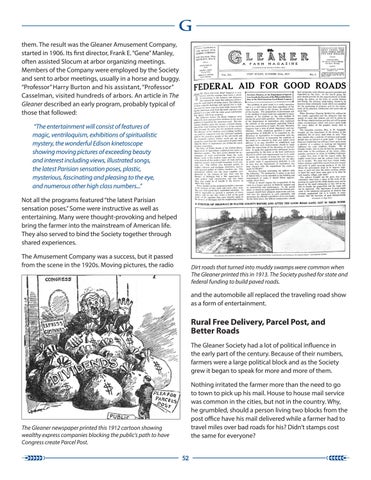them. The result was the Gleaner Amusement Company, started in 1906. Its first director, Frank E. “Gene” Manley, often assisted Slocum at arbor organizing meetings. Members of the Company were employed by the Society and sent to arbor meetings, usually in a horse and buggy. “Professor” Harry Burton and his assistant, “Professor” Casselman, visited hundreds of arbors. An article in The Gleaner described an early program, probably typical of those that followed: “The entertainment will consist of features of magic, ventriloquism, exhibitions of spiritualistic mystery, the wonderful Edison kinetoscope showing moving pictures of exceeding beauty and interest including views, illustrated songs, the latest Parisian sensation poses, plastic, mysterious, fascinating and pleasing to the eye, and numerous other high class numbers...” Not all the programs featured “the latest Parisian sensation poses.” Some were instructive as well as entertaining. Many were thought-provoking and helped bring the farmer into the mainstream of American life. They also served to bind the Society together through shared experiences. The Amusement Company was a success, but it passed from the scene in the 1920s. Moving pictures, the radio
Dirt roads that turned into muddy swamps were common when The Gleaner printed this in 1913. The Society pushed for state and federal funding to build paved roads.
and the automobile all replaced the traveling road show as a form of entertainment.
Rural Free Delivery, Parcel Post, and Better Roads The Gleaner Society had a lot of political influence in the early part of the century. Because of their numbers, farmers were a large political block and as the Society grew it began to speak for more and more of them. Nothing irritated the farmer more than the need to go to town to pick up his mail. House to house mail service was common in the cities, but not in the country. Why, he grumbled, should a person living two blocks from the post office have his mail delivered while a farmer had to travel miles over bad roads for his? Didn’t stamps cost the same for everyone?
The Gleaner newspaper printed this 1912 cartoon showing wealthy express companies blocking the public’s path to have Congress create Parcel Post. 52




















